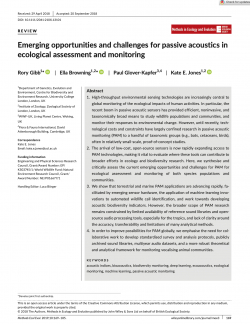Emerging opportunities and challenges for passive acoustics in ecological assessment and monitoring

Type
Journal
Authors
Gibb ( Rory Gibb )
Browning ( Ella Browning )
Glover-Kapfer ( Paul Glover-Kapfer )
Jones ( Kate E. Jones )
Category
Article
[ Browse Items ]
Publication Year
2018
Publisher
Methods In Ecology and Evolution, United Kingdom
URL
[ private ]
Volume
10 (2)
Pages
169-185
Tags
Abstract
1. High-throughput environmental sensing technologies are increasingly central to global monitoring of the ecological impacts of human activities. In particular, the recent boom in passive acoustic sensors has provided efficient, noninvasive, and taxonomically broad means to study wildlife populations and communities, and monitor their responses to environmental change. However, until recently, technological costs and constraints have largely confined research in passive acoustic monitoring (PAM) to a handful of taxonomic groups (e.g., bats, cetaceans, birds), often in relatively small-scale, proof-of-concept studies.
2. The arrival of low-cost, open-source sensors is now rapidly expanding access to PAM technologies, making it vital to evaluate where these tools can contribute to broader efforts in ecology and biodiversity research. Here, we synthesise and critically assess the current emerging opportunities and challenges for PAM for ecological assessment and monitoring of both species populations and communities.
3. We show that terrestrial and marine PAM applications are advancing rapidly, facilitated by emerging sensor hardware, the application of machine learning innovations to automated wildlife call identification, and work towards developing acoustic biodiversity indicators. However, the broader scope of PAM research remains constrained by limited availability of reference sound libraries and open-source audio processing tools, especially for the tropics, and lack of clarity around the accuracy, transferability and limitations of many analytical methods.
4. In order to improve possibilities for PAM globally, we emphasise the need for collaborative work to develop standardised survey and analysis protocols, publicly archived sound libraries, multiyear audio datasets, and a more robust theoretical and analytical framework for monitoring vocalising animal communities.
2. The arrival of low-cost, open-source sensors is now rapidly expanding access to PAM technologies, making it vital to evaluate where these tools can contribute to broader efforts in ecology and biodiversity research. Here, we synthesise and critically assess the current emerging opportunities and challenges for PAM for ecological assessment and monitoring of both species populations and communities.
3. We show that terrestrial and marine PAM applications are advancing rapidly, facilitated by emerging sensor hardware, the application of machine learning innovations to automated wildlife call identification, and work towards developing acoustic biodiversity indicators. However, the broader scope of PAM research remains constrained by limited availability of reference sound libraries and open-source audio processing tools, especially for the tropics, and lack of clarity around the accuracy, transferability and limitations of many analytical methods.
4. In order to improve possibilities for PAM globally, we emphasise the need for collaborative work to develop standardised survey and analysis protocols, publicly archived sound libraries, multiyear audio datasets, and a more robust theoretical and analytical framework for monitoring vocalising animal communities.
Description
https://doi.org/10.1111/2041-210X.13101
Number of Copies
1
| Library | Accession No | Call No | Copy No | Edition | Location | Availability |
|---|---|---|---|---|---|---|
| Main | 273 | 1 | Yes |



